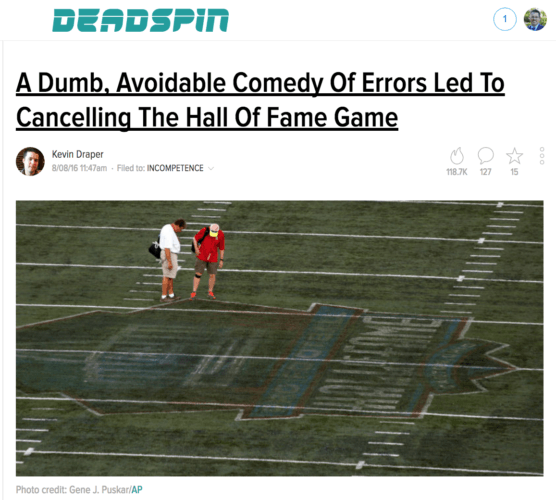The cancelation of a meaningless NFL exhibition pre-season game is probably one of the least important problems in the world. But, it happened recently and the “comedy errors” is interesting to think about.
You might notice the headline of my post. That's not the way a problem like this is normally portrayed in the news. Headlines and news stories usually blame an individual or ask who messed up. The answer to quality and problems and failures in an organization is rarely that simple.
Blame-y headlines in healthcare-related news include:
Surgeon accused of removing kidney from wrong patient
Nurse told colleague to ‘keep quiet' about surgeon's operation error, tribunal hears
But, everybody works in a system… even doctors: Blaming individual doctors for medical errors doesn't help anyone
In the less-important realm of sports, the pre-season “Hall of Fame” game in Canton, Ohio was canceled just before it was set to start on August 8th because the field was deemed unsafe. The first thing I'd do, as a Lean practitioner, is start asking “why?”
But, first the headlines:
Hall of Fame Game canceled due to unsafe field conditions
Congealed Paint Forces Cancellation Of NFL's Hall Of Fame Game
Hall of Fame Game canceled due to field concerns
Hall of Fame Game between Packers, Colts canceled
Field conditions force cancellation of preseason Hall of Fame Game
Those are surprisingly fact-based, blame-free headlines.
What happened?
In video form, via ESPN:
Why was the game called off?
The NFL and the union (the NFL Player's Association, or NFLPA) released a joint statement about their decision to call off the game:
“Due to safety concerns with the condition of the playing surface in Canton, tonight's game between the Indianapolis Colts and Green Bay Packers has been cancelled. We are very disappointed for our fans, but player safety is our primary concern, and as a result, we could not play an NFL game on this field tonight.”
Putting safety first is always a good thing. It bothers me that the NFL isn't always consistent on that front.
The game, again, is pretty meaningless, so why jeopardize player safety (any more than the game normally jeopardizes health and safety due to concussions and CTE, I guess). Safety first?
ESPN was probably pretty upset, since they were broadcasting the game and, since it's the NFL, people will watch. Fans were the most upset (a class action lawsuit was filed) because, while they had their ticket price refunded (a total of “several million dollars, per NPR), many had extra expenses because they traveled from Wisconsin or Indiana to attend the game. I'll quit pointing out they traveled for a meaningless game… value is defined by the customer, as we say.
So let's start asking “why?”
Why was the game canceled? The field was deemed unsafe for players
Why was the field deemed unsafe? There was concern that players' cleats would stick
Why did they think the cleats would stick? Paint on the field “was sticky and congealed into a hard mass” (Deadspin) and “the end zones and midfield logo almost tar-like” (SB Nation)
Why was the paint sticky or a hard mass? Reportedly, the wrong paint had been used (ESPN) and it was sticky
Why was the wrong paint used?
This is where most people would ask, “Who used the wrong paint?”
Instead of blaming a person, I'd ask questions that are more about the system and organization:
- Were there clear instructions or standard procedures for how to paint the field?
- Were people properly trained on how to paint the field?
- Was an error made where people thought they were using the right paint, but it was somehow mislabeled?
- Was there proper supervision?
- Were they in a rush for some reason?
We can ask the “Just Culture” questions and flowchart from the patient safety realm to see if this was a “person problem” or a “system problem.” I doubt a disgruntled employee intentionally sabotaged the field. It sounds like a number of mistakes, probably not being the result of anyone being an idiot or not caring.
This article says the field was being repainted, it seems like in a rush, after a Tim McGraw concert was held on August 5th, a few days before the game. The stage and everything caused problems that led to the attempted repainting.
Credit to SB Nation for avoiding blame: “It's not entirely Tim McGraw's fault the NFL cancelled the Hall of Fame game“
So it's possible the wrong paint was used… or maybe it just didn't have enough time to dry. Or, maybe that was a false lead in the investigation?
There's another branch of the “whys” questioning…
Why was the pain a hard mass? Rubber pellets in the base of the artificial surface melted
Why did they melt? Somebody tried heating the paint to dry it faster
Why did somebody try heating the paint? Why did nobody realize the pellets would melt? I believe the “FieldTurf” surface was brand new… did the old AstroTurf field have sand for “infill” instead of rubber pellets that are used with FieldTurf?
“The logos at midfield and the lettering in the end zone had, in fact, been painted well in advance. When the paint congealed, heaters were brought in and it only made the matter worse. The paint became even more sticky and in the process melted some of the rubber pellets that sit just below the surface of the FieldTurf.”
Of course, there are some concerns that the rubber pellets, made from recycled tires, could cause cancer. Safety first?
The snarkiest headline was from the blog Deadspin, as is their style:
A Dumb, Avoidable Comedy Of Errors Led To Cancelling The Hall Of Fame Game

It seems like a comedy of errors, not just one simple error. This happens all the time with healthcare errors (such as the tragic case of Emily Jerry's death).
Yeah, it was a preventable error, messing up that field. Was it dumb? I'd be more comfortable calling it “organizational stupidity” or “collective stupidity,” which happens even in an organization full of smart people.
As Deadspin snarkily summarized:
“So to recap, it sounds like some jamokes put house paint on the field; busted out hair blowers to try and dry paint that was sitting on top of small, rubber, easily meltable pellets; and finally tried to clean up the mess with a toxic and skin-melting chemical that was to be imminently rolled around upon by short-sleeved men.
Smart, very smart.”
Maybe this is just an example of the Hall of Fame organization having a new toy and not yet knowing how to take care of it? Whose responsibility is that… a front-line maintenance employee or the head of the organization?
How does a situation like this make you think about errors and problems in your workplace, healthcare or otherwise?
It makes me realize it's hard to do root cause analysis from afar, using news reports instead of going to the “gemba” or the place where the work actually occurs… but how often do people try solving and investigating workplace problems based on rumor or speculation, from an office or a conference room. Do we jump to conclusions instead of really investigating and problem solving?
Do we blame an individual who “should have known better?” Or do leaders take responsibility for the system… reacting in a blame-free, root-cause-investigating manner when a problem occurs? Or, better yet, are they proactive in planning and training, as to prevent silly mistakes that could kill a patient?
Please scroll down (or click) to post a comment. Connect with me on LinkedIn.
Let’s work together to build a culture of continuous improvement and psychological safety. If you're a leader looking to create lasting change—not just projects—I help organizations:
- Engage people at all levels in sustainable improvement
- Shift from fear of mistakes to learning from them
- Apply Lean thinking in practical, people-centered ways
Interested in coaching or a keynote talk? Let’s start a conversation.








![When Was the Last Time a Leader Around You Admitted They Were Wrong? [Poll]](https://www.leanblog.org/wp-content/uploads/2025/07/Lean-Blog-Post-Cover-Image-2025-07-01T212509.843-100x75.jpg)
